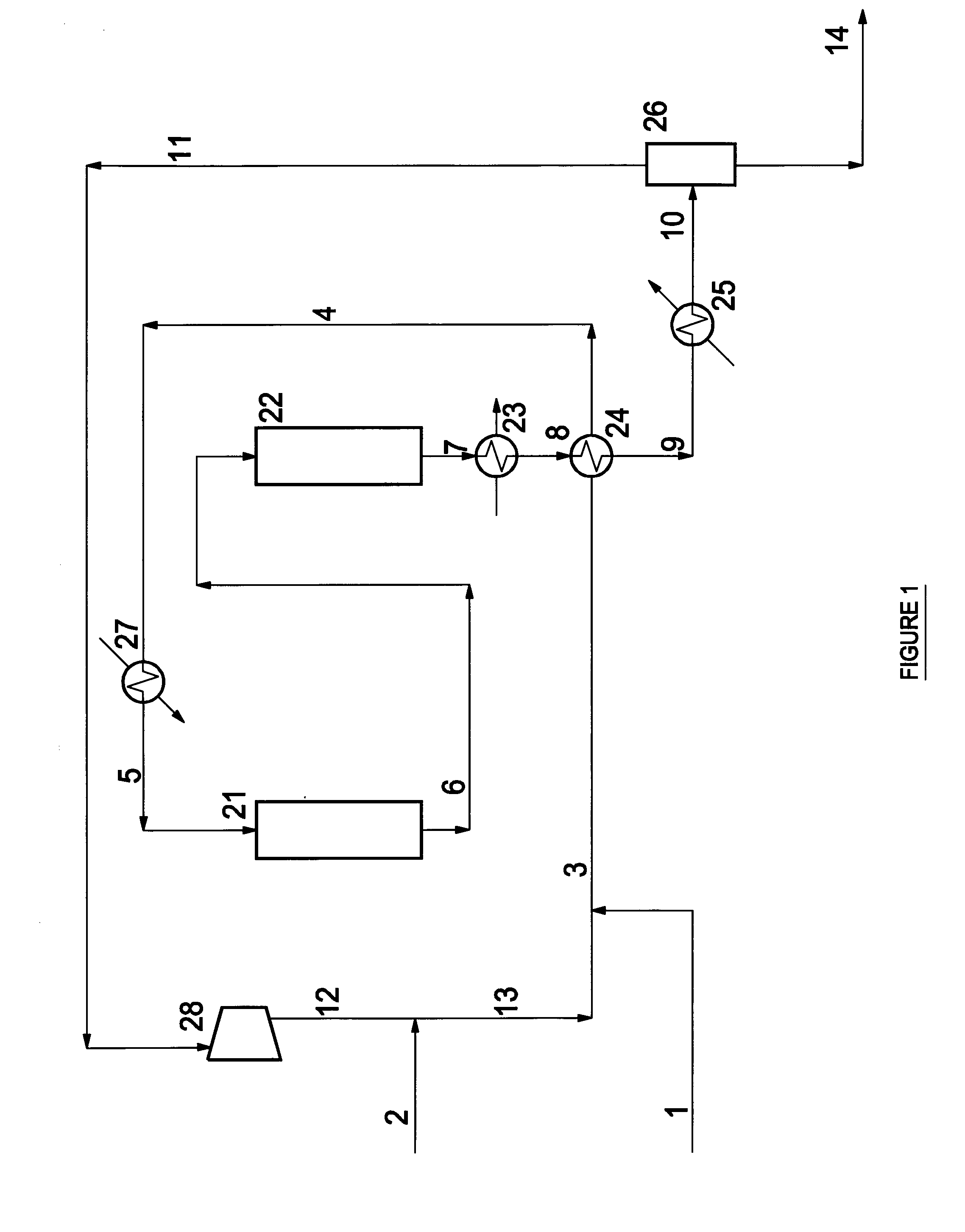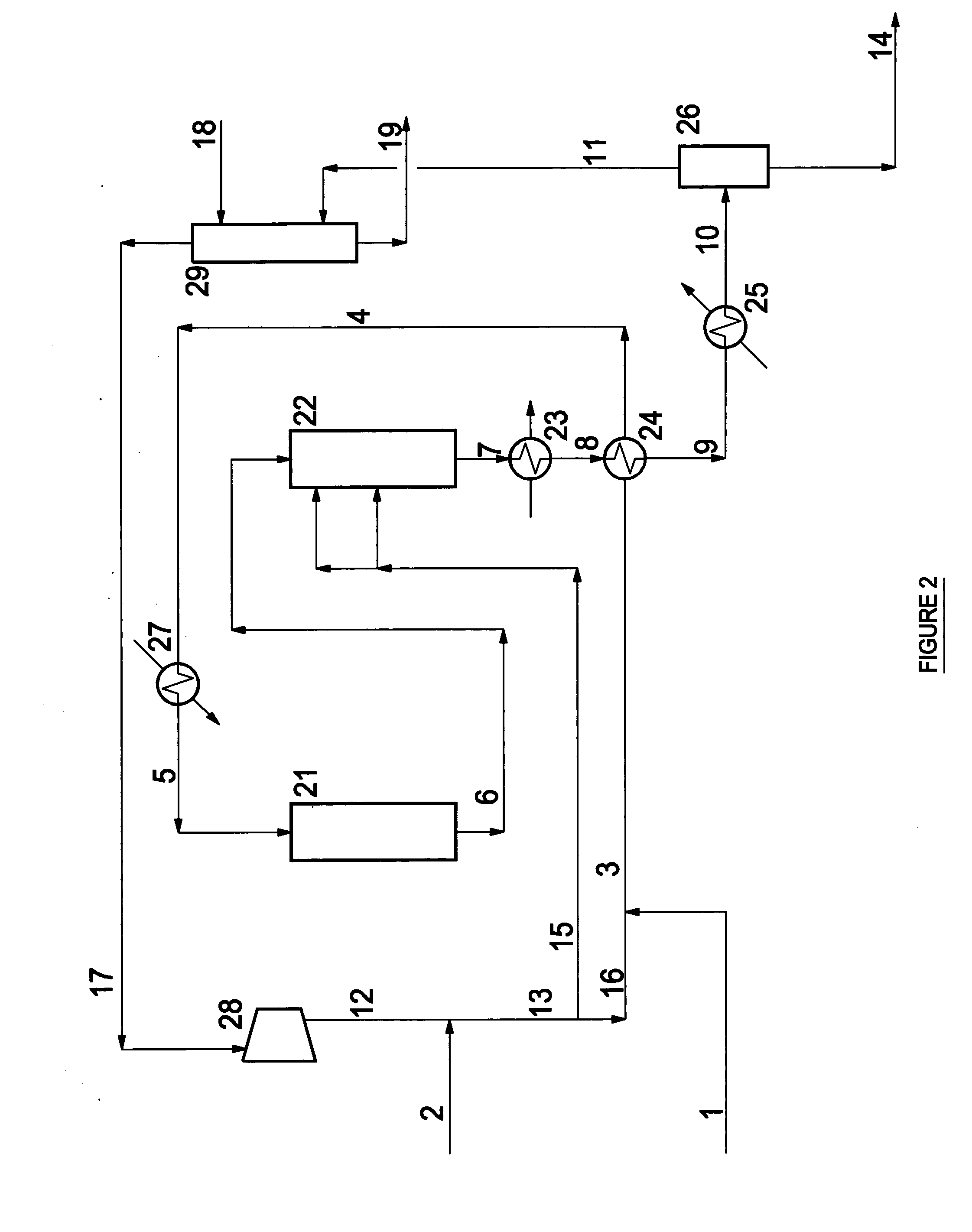Process for producing 1,4- butanediol by hydrogenating dialkyl maleate in mixed liquid/vapor phase
a technology of dialkyl maleate and mixed liquid/vapor phase, which is applied in the preparation of organic compounds, carboxylic acid esters, organic chemistry, etc., can solve the problems of large amount of recirculating hydrogen, poor success, and difficult control of catalytic beds, so as to achieve high boiling point, increase yield, and increase yield
- Summary
- Abstract
- Description
- Claims
- Application Information
AI Technical Summary
Benefits of technology
Problems solved by technology
Method used
Image
Examples
example 1
[0105]In this example 1 only the first reactor was used.
[0106]A stream of liquid DMM was fed to the first reactor with Palladium on carbon catalyst, under the following conditions:
Pressure: 60 barg
Temperature: 100 to 165° C.
[0107]Molar ratio H2 / DMM: 50
Liquid hourly Space Velocity: about 2
The main results of tests at different temperatures are shown in Table 2
TABLE 2DMM Hydrogenation to DMSTemperature ° C.Conversion %Selectivity to DMS %10010099.012010098.916510099.0
[0108]This example 1 shows the catalyst for the first step of reaction has both the necessary characteristics: i) high selectivity to the saturation of the carbon double bond and very low selectivity to the hydrogenolysis, ii) high activity to the saturation of the carbon double bond even at moderate temperature.
[0109]Even if, due to the small size of the laboratory equipment, the fully adiabatic conditions were not reproduced, a computer simulation of the conditions used during the test showed the increment of temperatur...
example 2
[0110]In this example 2 both reactor stages, as described in the Experimental apparatus, were used.
[0111]A stream of liquid DMM was fed to the first reactor with palladium on carbon catalyst, under the following conditions:
Pressure: 70 barg
Temperatures:
[0112]First stage outlet 130 to 135° C.
[0113]Second stage outlet 178 to 182° C.
Molar ratio H2 / DMM: 50
Liquid hourly Space Velocity:
[0114]First stage 2.0 hr−1
[0115]Second stage 0.2 hr−1
The main results of the analytical test are shown in Table 3
TABLE 3DMM Hydrogenation and Hydrogenolysis-DryconditionsDMM conversion100%Selectivity to95BDO / GBL / THFComposition (*)%THF13.09BuOH1.612Me THFless than 0.01Me-butyrate0.472-Metoxy-THFless than 0.014-Metoxy-BuOH0.44GBL4.861,4 BDO77.00DMS2.36Unknown 10.17Other unknownless than 0.01(*) net of water and methanol
example 3
[0116]In this example 3 the conditions of example 2 have been repeated, with the only difference of a small addition of water to the feed to simulate the conditions of an industrial plant, where the recycle gas is saturated by water.
The main results of the analytical test are shown in Table 4
TABLE 4DMM Hydrogenation and Hydrogenolysis-WetconditionsDMM conversion100%Selectivity to95.6BDO / GBL / THFComposition (*)%THF6.34BuOH0.692Me THFless than 0.01Me-butyrate0.222-Metoxy-THFless than 0.014-Metoxy-BuOH0.31GBL5.331,4 BDO83.96DMS2.20Unknown 10.95Other unknownless than 0.01(*) net of water and methanol
[0117]This example 3 shows that in wet conditions the overall results are very similar to the dry conditions ones, with the main difference in the yields in THF which drops from 13% to around 6%, being this difference compensated by an equivalent increased yield in BDO.
[0118]The overall yield in the three valuable products, BDO, GBL and THF, is 95.6%. Considering that the unreacted DMS may be...
PUM
| Property | Measurement | Unit |
|---|---|---|
| pressure | aaaaa | aaaaa |
| inlet temperature | aaaaa | aaaaa |
| inlet temperature | aaaaa | aaaaa |
Abstract
Description
Claims
Application Information
 Login to View More
Login to View More - R&D
- Intellectual Property
- Life Sciences
- Materials
- Tech Scout
- Unparalleled Data Quality
- Higher Quality Content
- 60% Fewer Hallucinations
Browse by: Latest US Patents, China's latest patents, Technical Efficacy Thesaurus, Application Domain, Technology Topic, Popular Technical Reports.
© 2025 PatSnap. All rights reserved.Legal|Privacy policy|Modern Slavery Act Transparency Statement|Sitemap|About US| Contact US: help@patsnap.com



